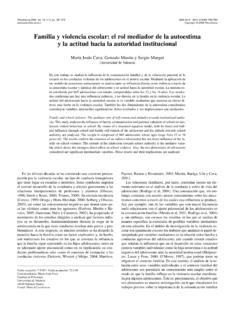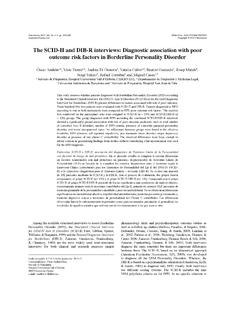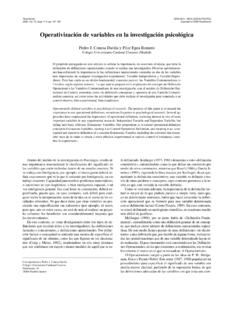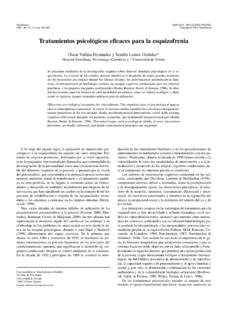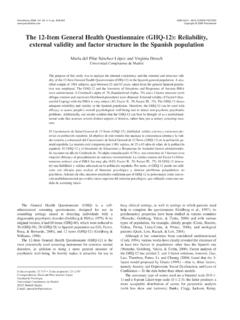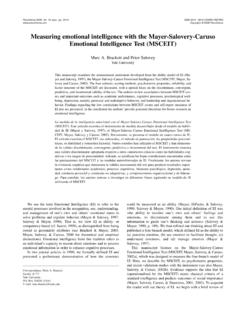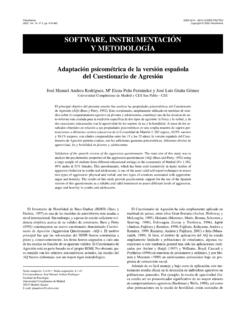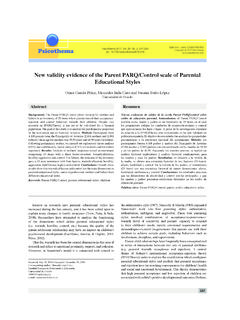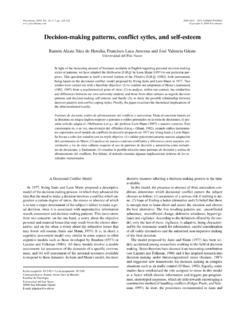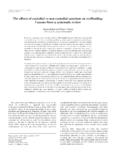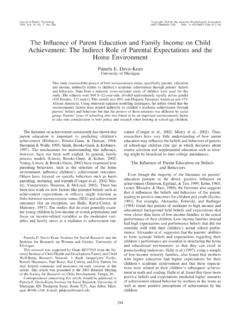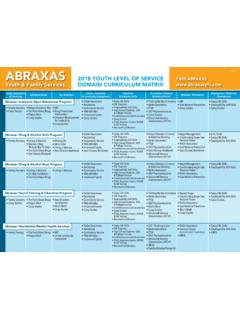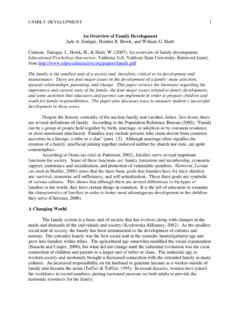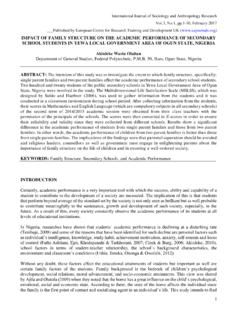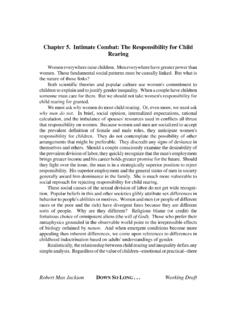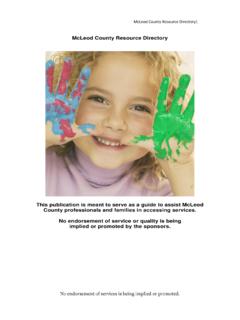Transcription of Dimensions of parenting styles, social climate, and ...
1 59 parenting styles and social climate are the most important factors for social development in children, to the extent that the ways children relate to each other refl ect the social climate they perceive in the family and the parenting approach underlying those (Smith & Moore, 2012).Baumrind (1971) settled two Dimensions in parenting styles -demandingness and responsiveness- that allowed the identifi cation of four parenting styles: Authoritative (when parents show high levels of demandingness and responsiveness), Permissive (low levels of demandingness and high levels of responsiveness), Authoritarian (high levels of demandingness and low levels of responsiveness) and Neglectful (low levels of both Dimensions ).
2 According to this quadrant, authoritative styles are the best way to encourage more positive socialization, although several studies carried out in Spanish population samples show that a certain level of authoritarianism promotes social development which is better adapted to norms (Musitu & Garc a, 2004). Other studies conclude that a permissive parental style is the best predictor of bullying victimization, whereas an authoritarian style is signifi cantly linked to aggressive behaviours (Georgiou, 2013).
3 In terms of family social climate, affection and communication are two of the main factors for adolescent adjustment. Thus, girls and boys who perceive more affection from their parents and enjoy a good relationship with them show better psychosocial development, higher emotional well-being and better behavioural adjustment (Oliva, Parra, S nchez-Queija, & L pez, 2007). Some authors suggest that the differences between the social climates of ISSN 0214 - 9915 CODEN PSOTEGC opyright 2018 of parenting styles, social climate, and bullying victimsin primary and secondary educationFuensanta Cerezo, Cecilia Ruiz-Esteban, Consuelo S nchez Lacasa, and Juli n Jes s Arense GonzaloUniversidad de MurciaAbstractResumenBackground: Bullying as a construct is found to be related to a variety of individual, parental and academic factors.
4 Familial factors include family environment, parenting style and parental involvement. The main aim of this study is to fi nd out how Primary and Secondary Education students perceive parenting styles and social climate and if there are differences between pupils from these two educational stages. The study also considers the relationship between these perceptions of bullying victims and certain peer socio-affective factors. Method: Participants were 847 children and adolescents.
5 School social climate and Family social climate were both evaluated using the Spanish version of Moos Family social Climate Scale, and parenting styles were evaluated according to the Parental Socialization Scale in Adolescence (ESPA29). Roles associated with bullying, and correlates of social reputation were measured using the Bull-S questionnaire. Results: There are differences in how primary and secondary education students perceive parenting styles and family climate. Conclusions: Parental factors are related to bullying victimization and socio-affective group variables ( social preference, acceptance or rejection levels, and the number of friends).
6 The study highlighs risk and protective factors for : Bullying victimization, Dimensions of parenting styles, social climate, primary education, secondary de estilos parentales, clima social y v ctimas de bullying en Educaci n Primaria y Secundaria. Antecedentes: considerado el bullying como constructo, encontramos relaci n con una variedad de factores individuales, parentales y acad micos asociados. Los factores familiares incluyen el clima familiar y los estilos de crianza.
7 El objetivo principal de este estudio es analizar c mo perciben los estilos de crianza y el clima social los estudiantes de Educaci n Primaria y Secundaria y si existen diferencias entre los estudiantes de estas dos etapas. El estudio tambi n trata sobre la relaci n de estas percepciones entre las v ctimas de bullying y ciertos factores socio-afectivos de los iguales. M todo: participaron 847 j venes y adolescentes. El clima social familiar y escolar fueron evaluados utilizando la Escala de Clima social Familiar de Moos y los estilos de Crianza de los Padres fueron evaluados de acuerdo a la Escala ESPA29.
8 Roles asociados al bullying y reputaci n social se midieron mediante el cuestionario Bull-S. Resultados: se encuentran diferencias entre los estudiantes de Educaci n Primaria y Secundaria en la percepci n de los estilos de crianza y clima familiar. Conclusiones: los factores parentales se relacionan con la victimizaci n por bullying y con variables socio-afectivas del grupo (preferencia social , aceptaci n o rechazo y el n mero de amigos). Se se alan factores de riesgo y de protecci n de victimizaci clave: victimas de bullying, dimensiones de estilos de crianza, clima social , Educaci n Primaria y Educaci n 2018, Vol.
9 30, No. 1, 59-65doi: Received: November 25, 2016 Accepted: September 22, 2017 Corresponding author: Cecilia Ruiz-EstebanFacultad de Psicolog aUniversidad de Murcia30100 Murcia (Spain)e-mail: Cerezo, Cecilia Ruiz-Esteban, Consuelo S nchez Lacasa, and Juli n Jes s Arense Gonzalo60bullies and victims families can be found in their parents degree of involvement and support, both being lower for the victims (Cerezo, S nchez, Ruiz-Esteban, & Arense, 2015).The second socialization source is found in the school environment, where dysfunctional interpersonal relationships stand out as the source of school confl ict or bullying problems (Farrington, Loeber, Stallings, & Ttofi , 2011; Hong & Espelage, 2012).
10 Bullying is an abusive behaviour that includes several strategies, from physical abuse to social exclusion, usually not exclusive, but concentrating different forms of abuse in the same victim, triggered by a feeling of peer rejection, which isolates and takes support away from the assaulted student (Salmivalli, 2010). Some studies link school victimization to permissive parenting patterns (Estevez, Murgui, Moreno, & Musitu, 2007; Georgiou & Stavrinides, 2013). Other studies suggest that parental support and family relationships are not related to victimization (Baldry, 2004), whereas others conclude that victimization and deviant behaviour are infl uenced by negative control (Samper-Garc a, Mestre-Escriva, Malonda-Vidal, & Mesurado, 2015) and parent-adolescent communication (Herrero, Estevez, & Musitu, 2006).
